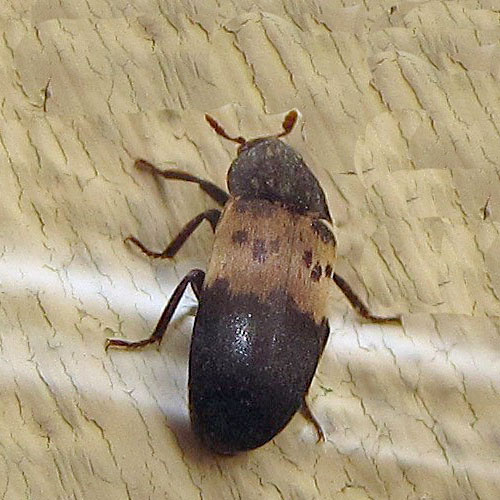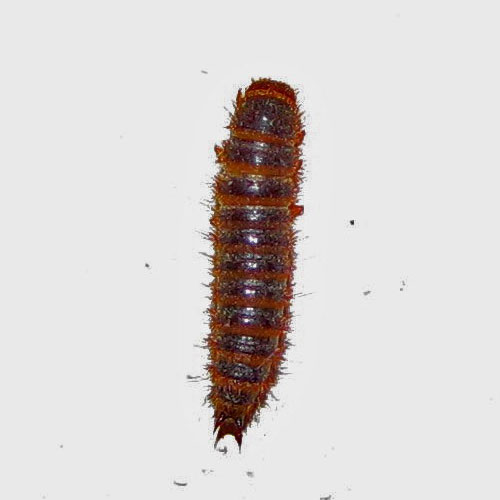Greetings, BugFans,
Larder Beetles
One of the permanent residents of the BugLady’s house is the larder beetle, whose movements along the base of the walls she catches out of the corner of her eye. Larder beetles, in the beetle family Dermestidae, are small (about ¼”), dark, compact, short-legged beetles that often have a covering of scales or hairs. Their larvae are dark, reddish-brown and bristly, and are a bit bigger than their parents. Both larvae and adults like the shadows. In 1942, S. W. Frost wrote in Insect Life and Natural History that there are not many insect species that are cosmopolitan in distribution (although the list has undoubtedly grown in the last 65 years). His list included “some beetles, especially those that live in domestication,” and he specified the larder beetle (Dermestes lardarius) as one of them.
In the wild, they serve as the clean-up committee, scavenging on dried carrion (in the “jerky” stage of decomposition), on animal droppings, on leftovers in animal nests, and on the corpses in old bee hives and at the outskirts of spider webs. The larvae are the chief culprits here (some adults eat pollen and other flower parts and others continue to eat their larval foods).
Just what do they eat in the larder? Names like “skin beetle,” “carpet beetle,” “hide beetle,” “larder beetle,” “bacon beetle,” and “bow bugs” (they invade violin cases and eat the horsehair strings on the bow) suggest what the various species are up to indoors. Dermestid family members eat some high-protein dried plants, but their primary targets are stored animal materials like cured bacon and ham, dry pet food and dog biscuits, cheese, cereal, hides, wool carpets, upholstery and clothing. Historically, when dermestid damage ruined entire shipments of animal hides, London merchants offered a reward of £20,000 to anyone who could come up with an extermination strategy. A dermestid was reported on Egyptian mummies in 1843, and many a hapless entomologist has forgotten up upgrade the mothballs in his/her insect collection, only to discover that D. lardarius has eaten the specimens right off their pins.
Is that the only bad news? There is another downside (at least from our perspective): Mom lays more than 100 eggs near a food source. The kids hatch in 12 days, eat for about 12 days, pupate for about 15 days and emerge ready to make more beetles. The larvae prefer to make their pupal chambers in a really tough material. Like wood. Or plaster. They can chew through tin and lead, so insulation is no challenge at all. If a house has a large infestation, their burrowing may cause some structural damage. Larder beetle control is difficult; it’s hard to clean up all the infested materials when the beetles are in between your walls noshing on dead insects there, or are tucked into pupal cases within those same walls.
Are there any up-sides? Larder beetle relative D. maculatus is used by museum workers to “remove” flesh from specimens when a clean skeleton is needed. They are also a CSI tool, because, like the green bottle blow flies of previous BOTW fame, their life cycles have been thoroughly mapped, and the presence of adults or larvae can be used to “age” corpses. The BugLady thinks it’s great that they want to clean up the crumbs of dry dog food that fall from her dog’s lips, but rambling through the cats’ litter box? Yuck!
The BugLady

